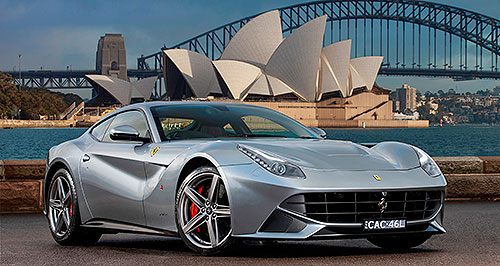Ferrari's fastest touches down
BY MIKE COSTELLO | 4th Jul 2013

Ferrari’s $691,100 (plus on-road costs) monster from Maranello sweeps its predecessors before it with a 546kW/690Nm 6.3-litre V12 powerplant, zero to 100km/h sprint time of 3.1 seconds and circa 340km/h top speed.
It also posted the fastest lap for a road car at Ferrari’s Fiorano test circuit at 1:23 – a second quicker than the lightweight, track-oriented GTO version of its 599 forebear and two seconds quicker than the legendary Enzo hypercar.
Ferrari Australia says it has taken a number of forward orders from local buyers who, incidentally, pay among the world’s highest prices for products wearing the Prancing Horse badge.
As a result, the waiting list for the F12 has been pushed out to 18 months. The first of the early customer orders will arrive here within a few months.
“We are extremely excited to have the F12 Berlinetta arrive in Australia, as it sets a new benchmark for extreme sports cars and will be the epitome of the Ferrari range offered to our clients,” says Ferrari Australasia CEO Herbert Appleroth.
Peak power from the V12 comes in at a screaming 8500rpm before hitting the 8700rpm redline while maximum torque arrives at 6000rpm, with 80 per cent available from just 2500rpm.
The Lamborghini Aventador matches the F12 for torque but its 515kW peak power output falls some way short of the Ferrari – although the Raging Bull’s all-wheel-drive system helps it dispatch the run to triple digits three tenths quicker.
Ferrari has shrunk the F12 compared with the 599 while trimming weight by 70kg and reducing drag but increasing downforce by 76 per cent – and the company claims it has liberated more interior and luggage space despite the more compact dimensions.
Ferrari has mounted the F12’s engine, dashboard and seats lower in the chassis to achieve a lower centre of gravity and slightly more rear weight bias than in the 599, with front/rear weight distribution at 46:54.
A new spaceframe chassis design and bodyshell using 12 types of alloy, combined with new assembly and joining techniques are said to increase the F12’s structural rigidity by 20 per cent, aiding ride, handling and safety.
The latest carbon-ceramic brakes are standard and are said to “drastically” reduce stopping distances and the F12 is claimed to deliver “maximum driving involvement” due to sharper steering and the ability to achieve higher cornering speeds.
